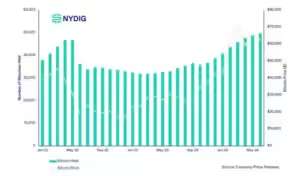Decline in New Bitcoin Wallets Hits Lowest Level Since 2018

QUICK TAKE
- The seven-day moving average of new Bitcoin addresses has dropped to its lowest since 2018.
- Six months ago, new address creation surged due to excitement around spot Bitcoin ETFs, Ordinals, and the upcoming halving.
- Recent data shows a significant decrease, with only 275,000 new addresses added daily compared to 625,000 six months ago.
- Miner revenue, transaction fees, and on-chain volume metrics have also declined.
Bitcoin Wallet Growth Hits Lowest Level Since 2018
In a surprising turn for the cryptocurrency world, the number of new Bitcoin wallets has dropped to its lowest level since 2018. This decline, tracked through the seven-day moving average of new addresses on the Bitcoin network, marks a stark contrast to the surge witnessed just six months ago. During that period, the market was buoyed by enthusiasm for spot Bitcoin ETFs, advancements like Ordinals, and anticipation of the upcoming halving event. These factors drove the weekly average of new Bitcoin addresses to near-record levels, reminiscent of the all-time high in December 2017.
The Decline in New Addresses
However, the fervor that once gripped the Bitcoin ecosystem has significantly waned. According to data from The Block, the past week’s average shows only 275,000 new addresses being added to the Bitcoin network daily. This figure represents a dramatic drop from the 625,000 new addresses recorded six months prior. This downturn parallels the situation in early 2018, when the initial excitement around Bitcoin projects dissipated, leading to a similar reduction in new address creation.
Impact on Network Metrics
The decline in new addresses is not an isolated phenomenon; it reflects broader trends affecting the Bitcoin network. Key metrics such as miner revenue, transaction fees, and on-chain volume have also seen significant reductions. The hash rate, a critical measure of the network’s security and miner activity, has dropped to record lows. Similarly, transaction fees have decreased, indicating lower network congestion and activity. On-chain volume, which measures the total value of transactions processed by the network, has also fallen, suggesting a reduction in overall Bitcoin usage.
Possible Causes
Several factors could be contributing to this downturn. Market sentiment has cooled following the initial hype around new Bitcoin-related projects. Additionally, broader economic conditions, regulatory uncertainties, and competition from other cryptocurrencies and blockchain platforms may be playing a role. The decrease in miner revenue and hash rate could also be linked to changes in mining profitability and operational costs, which are influenced by Bitcoin’s price movements and energy prices.
Potential for Future Growth
Despite the current slump in on-chain metrics, there are signs that the Bitcoin network could experience a resurgence. Recent reports by The Block indicate that novel protocols on the Bitcoin network are drawing unprecedented levels of interest from venture capital firms. This influx of capital could foster innovation and development within the ecosystem, potentially driving future growth and renewed user engagement.
One such area of interest is the development of new financial products and services built on the Bitcoin blockchain. These innovations could enhance the utility of Bitcoin, making it more attractive to a broader audience and encouraging the creation of new addresses. Additionally, the upcoming Bitcoin halving, which will reduce the block reward for miners, could impact the supply-demand dynamics of Bitcoin, potentially leading to price increases and renewed interest in the network.
Looking Ahead
The current decline in new Bitcoin addresses serves as a reminder of the cyclical nature of the cryptocurrency market. Periods of intense growth and adoption are often followed by corrections and consolidations. However, the underlying technology and the continuous interest from investors and developers suggest that Bitcoin remains a crucial player in the digital asset space.
As the market evolves, it will be essential to monitor key metrics such as address creation, hash rate, and on-chain volume to gauge the network’s health and growth prospects. While the immediate outlook may appear challenging, the potential for innovation and the upcoming halving event provide reasons for cautious optimism.
In conclusion, the Bitcoin network is experiencing a significant downturn in the number of new addresses, echoing the patterns seen in early 2018. This decline, coupled with reductions in miner revenue, transaction fees, and on-chain volume, highlights the current challenges facing the Bitcoin ecosystem. However, the sustained interest from venture capital in new Bitcoin protocols suggests that the network could see a resurgence in the future. As always, the cryptocurrency market remains dynamic, with periods of decline often setting the stage for future growth and innovation.



